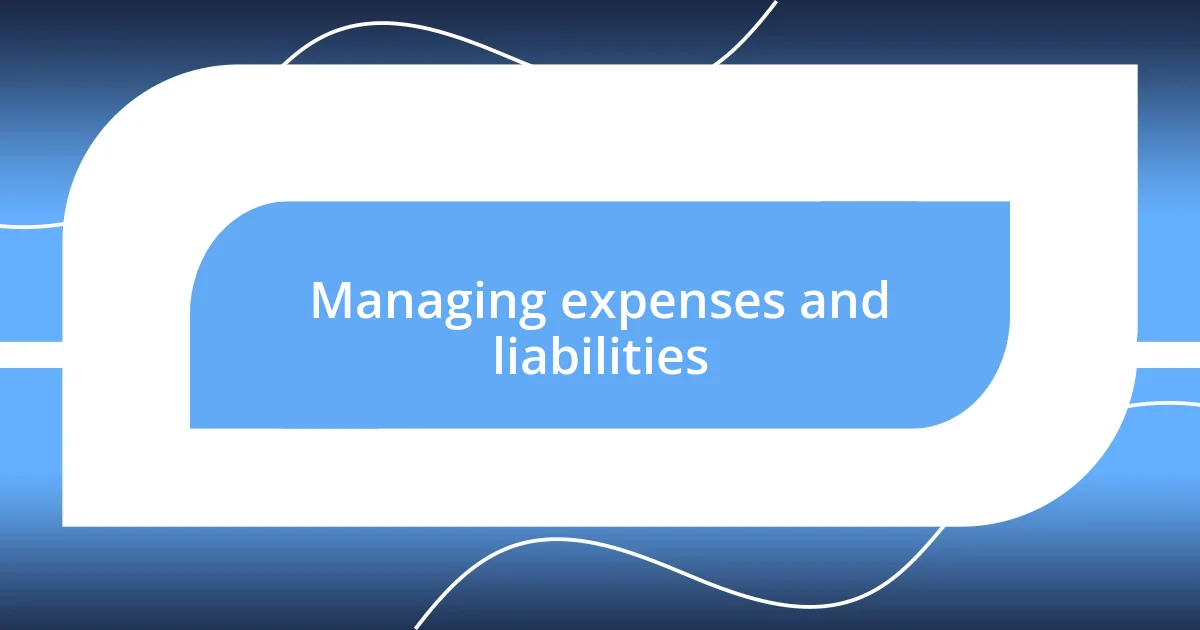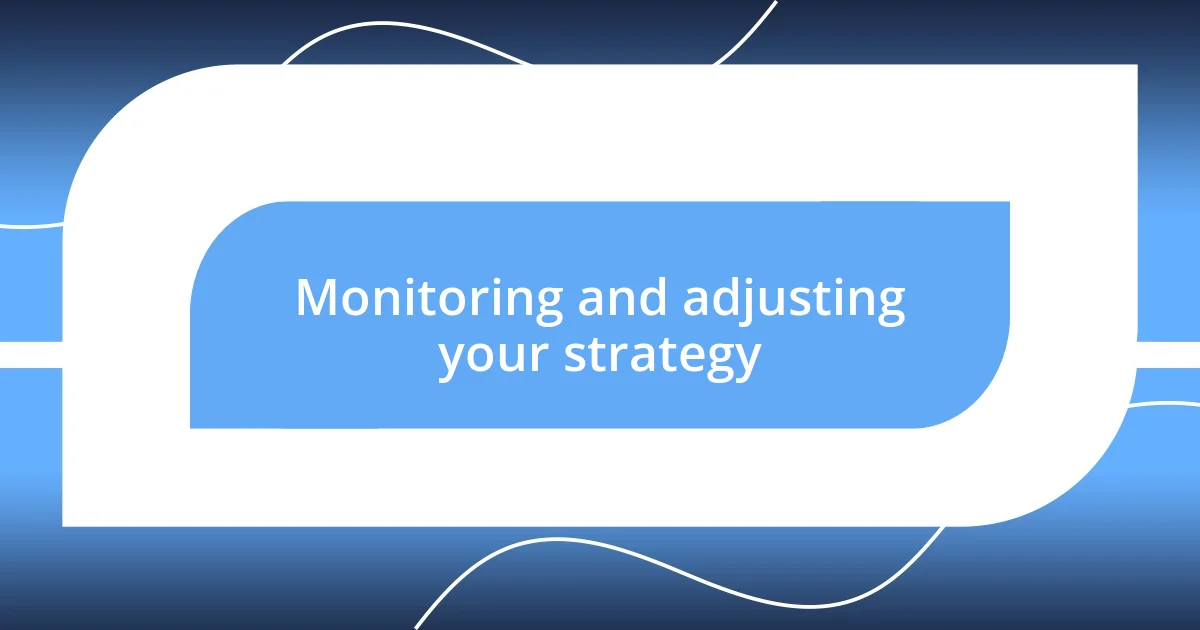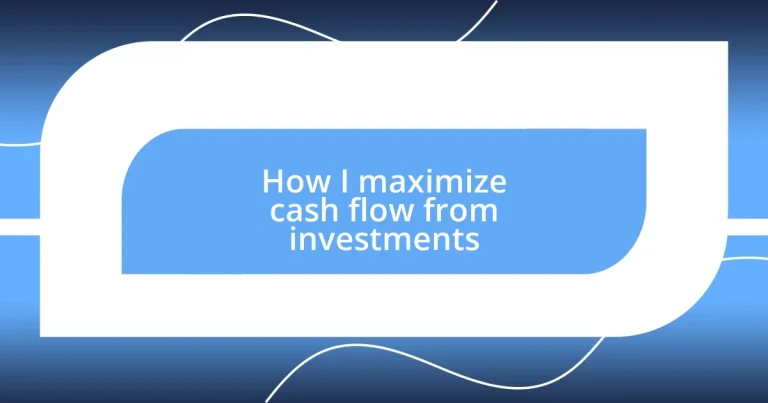Key takeaways:
- Understanding cash flow is essential for effective investment management; it involves the movement of money in and out over time.
- Diversifying cash flow sources and regularly monitoring income streams can stabilize finances and reveal growth opportunities.
- Utilizing tax-efficient investment options and monitoring strategic performance are crucial for maximizing cash flow and achieving long-term financial goals.

Understanding cash flow basics
Cash flow is often described as the lifeblood of any investment. I remember when I first grasped this concept; it was a turning point in my financial journey. How can you effectively manage and maximize your investments if you don’t fully understand where your money is coming from and where it’s going?
At its core, cash flow refers to the movement of money in and out of your investments over a specific period. I’ve seen too many people focus only on profits without considering cash flow, leaving them in a tight spot when expenses arise. Have you ever faced a situation where you thought you were doing great, only to realize that bills were piling up? Understanding this ebb and flow has helped me prepare for those inevitable fluctuations.
Positive cash flow means your investment is earning more than it costs you, allowing for growth and the opportunity to reinvest. I recall an instance with one of my rental properties; initially, the cash flow was tight, but after refining my approach to expenses and income generation, I enjoyed a healthy surplus. It’s about making informed decisions that keep the cash flowing in your favor.

Identifying cash flow sources
Identifying cash flow sources is a fundamental step in maximizing your investment returns. I often find the most effective approach is to take a close look at where my money is coming from. For example, in my own journey, I initially overlooked the importance of tracking every possible income source and how each could contribute to my overall cash flow. It’s like piecing together a puzzle; once I recognized all the pieces, a clearer financial picture emerged.
Another critical aspect to consider is diversifying your cash flow sources. I’ve learned that relying on a single stream can be risky. When I expanded my portfolio beyond just rental properties to include dividend stocks and even peer-to-peer lending, I noticed a significant shift. Not only did it stabilize my cash flow, but it also provided newfound opportunities for growth. Diversification isn’t just a buzzword; it’s a vital strategy from my experience.
Monitoring these sources regularly has also brought me immense clarity. I set up monthly reviews of my cash flow statements, which has kept me proactive rather than reactive. I vividly remember the time I adjusted my real estate strategies based on these insights, allowing me to turn potential losses into gains. By staying engaged with my cash flow sources, I can make informed choices that really resonate with my financial goals.
| Cash Flow Source | Description |
|---|---|
| Rental Income | Income generated from leasing properties to tenants. |
| Dividend Stocks | Payments made by companies to shareholders, usually from profits. |
| Peer-to-Peer Lending | Interest earned from loans given to individuals through online platforms. |
| Real Estate Investment Trusts (REITs) | Companies that earn income through real estate investments and distribute it as dividends. |

Evaluating investment opportunities
Evaluating investment opportunities requires a systematic approach, which I’ve found extraordinarily helpful in my own experience. I recall early on trying to seize every opportunity that came my way, only to realize I was spreading myself too thin. Being selective and evaluating each potential investment rigorously has improved my decision-making significantly. It’s like being a detective; you want to gather all the clues before forming a hypothesis, right?
To help with evaluation, I recommend considering the following key factors:
- Risk Assessment: Determine the level of risk involved. What’s your tolerance?
- Research: Look into the investment’s historical performance and market trends to gauge potential.
- Due Diligence: Investigate the details, like the condition of an asset or the credibility of a business.
- Cash Flow Projections: Analyze expected income versus expenses. Is there a cushion for unexpected costs?
- Alignment with Goals: Ensure it fits your broader financial strategy—does it serve your long-term objectives?
I’ve learned that regularly revisiting these evaluation criteria keeps me grounded and allows me to make informed choices that feel right. When I recently passed on an enticing investment opportunity that didn’t fit my criteria, it was a difficult decision but ultimately the right one; the peace of mind that followed was invaluable.

Strategies for maximizing cash flow
One strategy I’ve found invaluable in maximizing cash flow is optimizing expenses. When I first began my investment journey, I was surprised by how little attention I paid to managing costs. I decided to conduct a thorough review of all my ongoing expenses, from property management fees to utility bills. This exercise revealed areas where I could renegotiate rates or find alternative providers. By trimming excess costs, I significantly boosted my net cash flow, and it felt empowering to take control of my finances in such a tangible way.
Leveraging technology can also enhance cash flow management. I remember the day I discovered financial software that streamlined my tracking process. It not only aggregated income and expenses but also highlighted trends and potential red flags. This real-time awareness helped me make timely adjustments. You might ask, “How does this translate to cash flow?” Well, the quicker I identified discrepancies, the sooner I could react or improve processes. It’s a bit like having a financial dashboard at my fingertips—seeing everything in one place truly changed the game for me.
Another approach I highly recommend is reinvesting cash flow wisely. Early on, I made the mistake of letting excess cash sit idle in a low-interest account. However, once I began reinvesting that cash into high-yield opportunities—like additional rental properties or higher-dividend stocks—I witnessed a marked increase in my overall cash flow. It’s almost like feeding a plant; the more attention and resources you give it, the more it thrives. Whenever I see my investments compound over time, it reaffirms my belief that strategic reinvestment is key to financial growth.

Managing expenses and liabilities
Managing expenses effectively has been a game-changer for me. In the early days of my investing journey, I overlooked small, recurring costs thinking they were inconsequential. It wasn’t until I started tracking these expenses that I realized they accumulated into a significant drain on my cash flow. For instance, renegotiating my property insurance resulted in a surprising annual saving—money that I could immediately redirect toward my investments. Isn’t it fascinating how fine-tuning can lead to such impactful changes?
On the other hand, managing liabilities is equally crucial. When I first acquired multiple rental properties, I fell into the trap of taking on more debt than I could manage. I vividly remember the stress it caused—balancing mortgage payments while dealing with unexpected repairs felt like juggling too many balls in the air. Eventually, I learned to prioritize paying down high-interest debts first. This strategy not only eased my financial burden but also allowed more cash to flow into my ongoing investments. Have you experienced that sense of relief when you’ve tackled a significant liability?
Moreover, I find it essential to maintain an active mindset regarding my financial health. Regularly reviewing my expenses and liabilities keeps me aligned with my goals. I embraced the practice of setting aside time each month to assess my financial standing. This habit isn’t merely about crunching numbers; it’s about being aware of where my money goes and how it impacts my overall cash flow. After all, wouldn’t you agree that knowing your financial landscape fosters confidence in your investment decisions?

Utilizing tax-efficient investment options
Utilizing tax-efficient investment options has significantly impacted my financial strategy. Early in my investing journey, I felt overwhelmed by taxes and their potential to eat away at my returns. When I discovered tax-advantaged accounts, like IRAs and 401(k)s, it was as if a light bulb went off. By taking full advantage of these options, I was able to grow my investments tax-deferred, which helped me realize the power of letting my money work harder for me over time. Have you thought about how much more you could accumulate by minimizing taxes on your gains?
I’ve come to appreciate municipal bonds for their tax benefits, too. When I invested in these bonds, I felt a sense of relief knowing that the interest earned wouldn’t be subject to federal taxes. This realization changed the game for me, as I could confidently retain more of my hard-earned income. It’s a unique feeling to see your investment actively contributing to your cash flow while also being tax-efficient. Isn’t it exhilarating to think about where you could allocate that tax savings toward your next investment opportunity?
Real estate investing has also taught me about the benefits of depreciation. Initially, I didn’t understand how this non-cash expense could impact my tax situation until I engaged with a tax advisor. Learning how to leverage depreciation deductions made me feel smarter about managing my properties and allowed me to offset some of my taxable income. This can be a powerful tool if you’re looking to maximize cash flow while minimizing taxes. Have you considered seeking professional advice on how to utilize these strategies to your benefit?

Monitoring and adjusting your strategy
Keeping an eye on my investment strategy has been integral to enhancing my cash flow. I’ve learned that merely setting it and forgetting it doesn’t cut it. For instance, I remember a time when I was heavily invested in one specific sector. When I noticed a dip in performance, I took the opportunity to reallocate funds into a more diversified mix. That swift adjustment not only protected my cash flow but also allowed me to capture new growth opportunities. Have you ever felt that urgency to pivot when things weren’t looking right?
Moreover, I regularly set aside time for a thorough review of my portfolio. This process isn’t just number-crunching; it’s about understanding what’s working and what’s not. I believe one of the most eye-opening moments was when I realized my tech stocks had been great at generating returns but had also introduced considerable volatility into my cash flow. I started comparing their performance to other sectors more aligned with my cash flow goals. This shift in perspective allowed me to fine-tune my investments, leading to a much steadier cash flow. Isn’t it empowering to take control in such a direct way?
Ultimately, monitoring goes beyond simply tracking numbers; it involves emotional awareness as well. I’ve learned to pay attention to market trends and shifts in my personal investing goals. Each time I felt anxious about external economic changes, I reassessed my approach and sought advice from trusted sources. This proactive mindset not only alleviated my worries but also enriched my investing knowledge. How do you handle those moments of uncertainty when the market seems on shaky ground?














